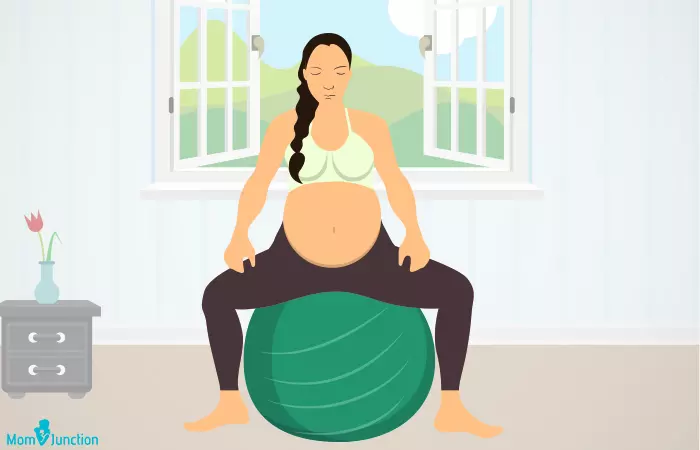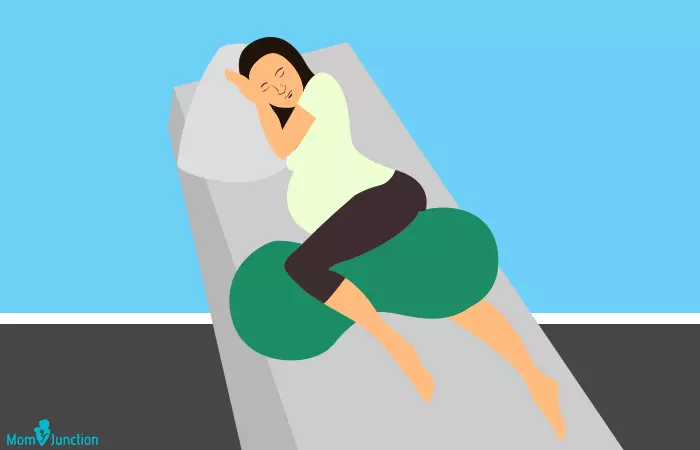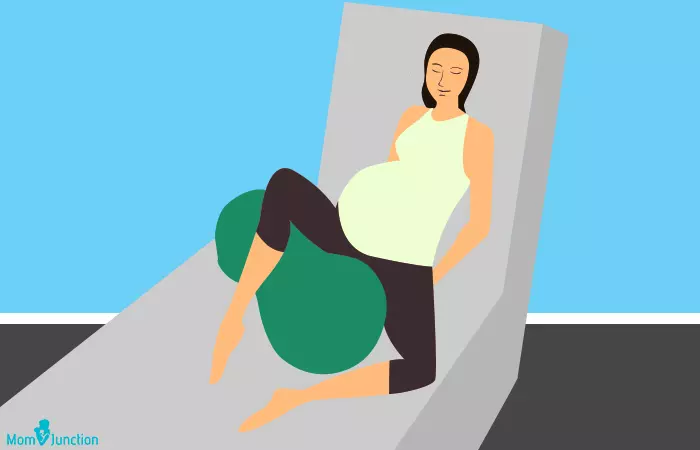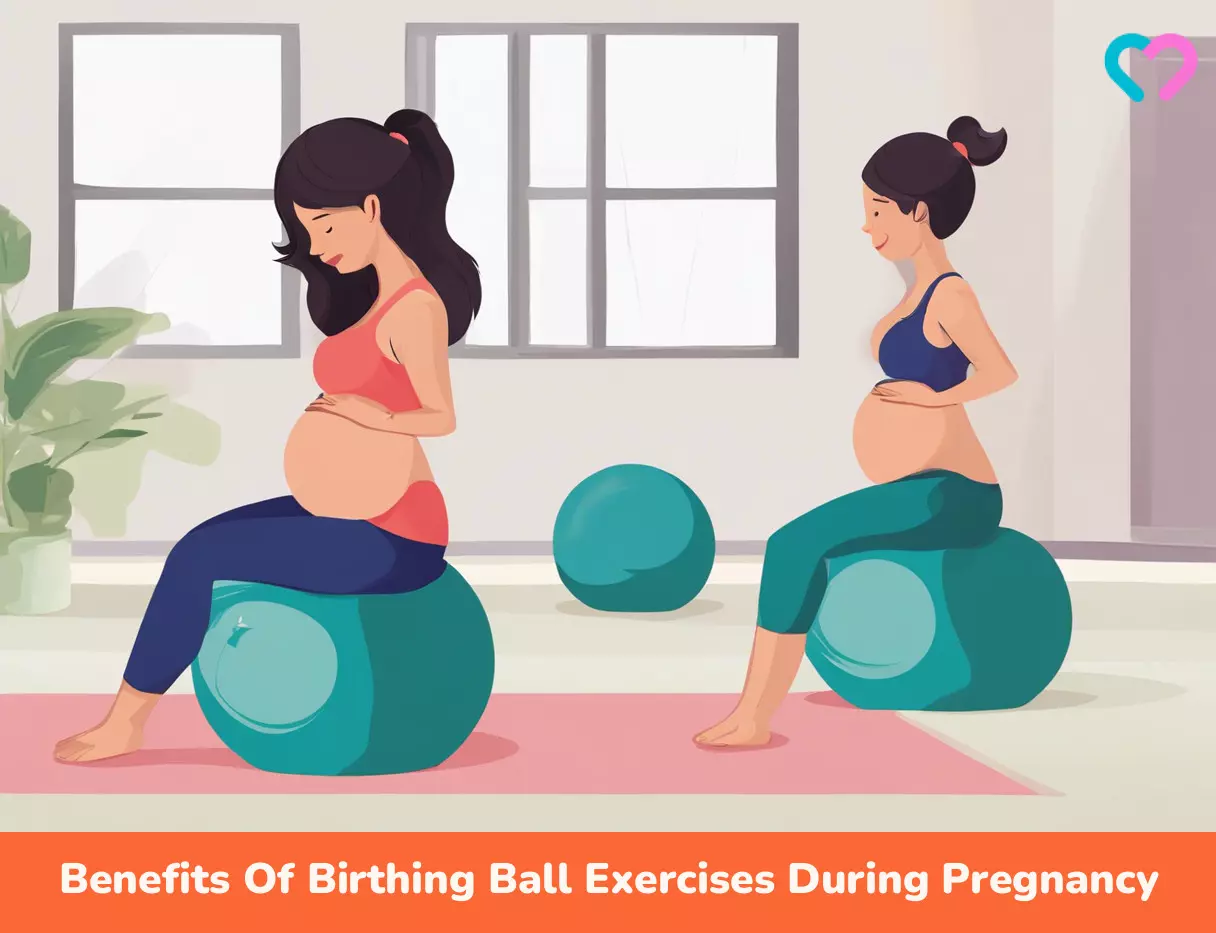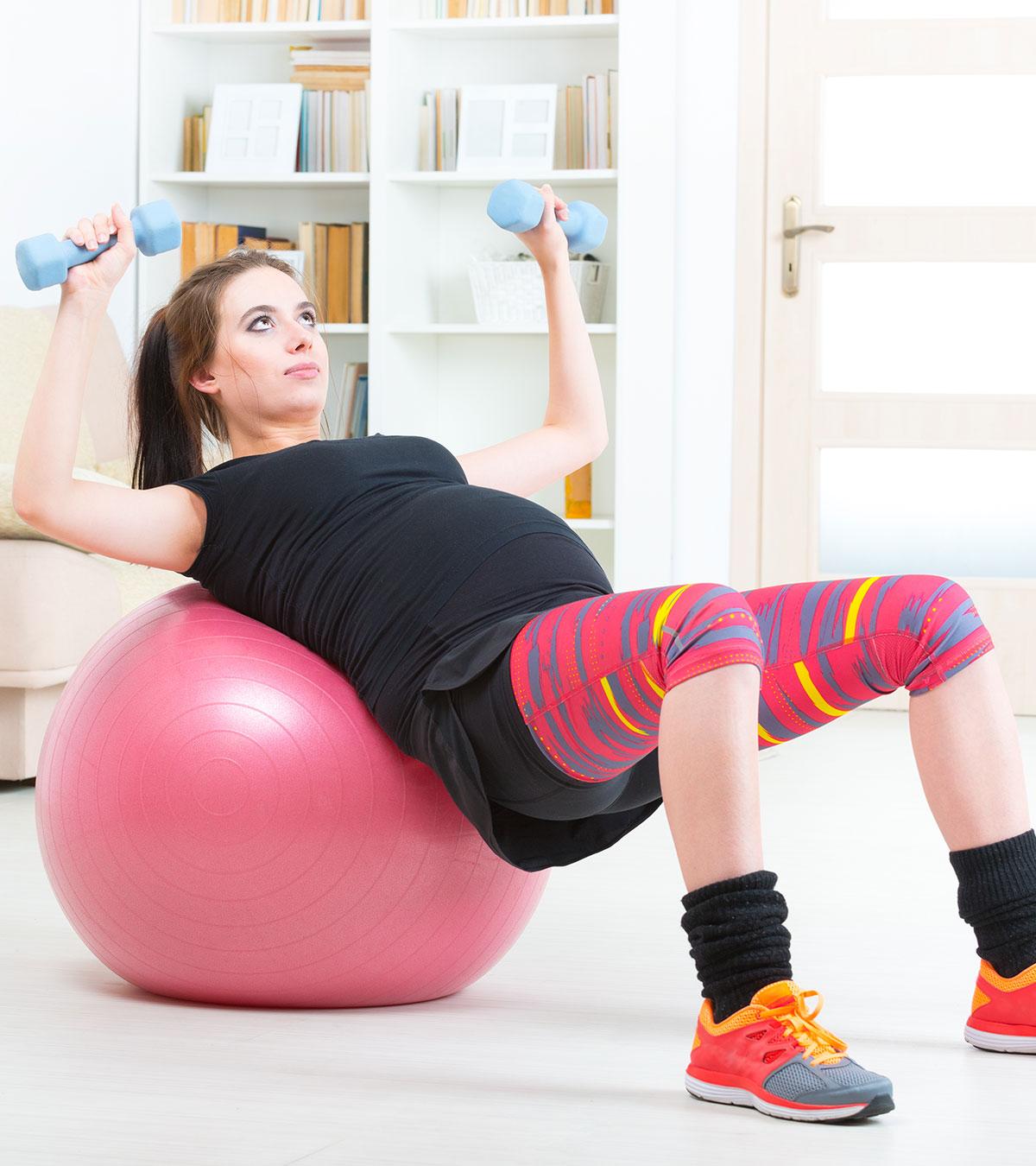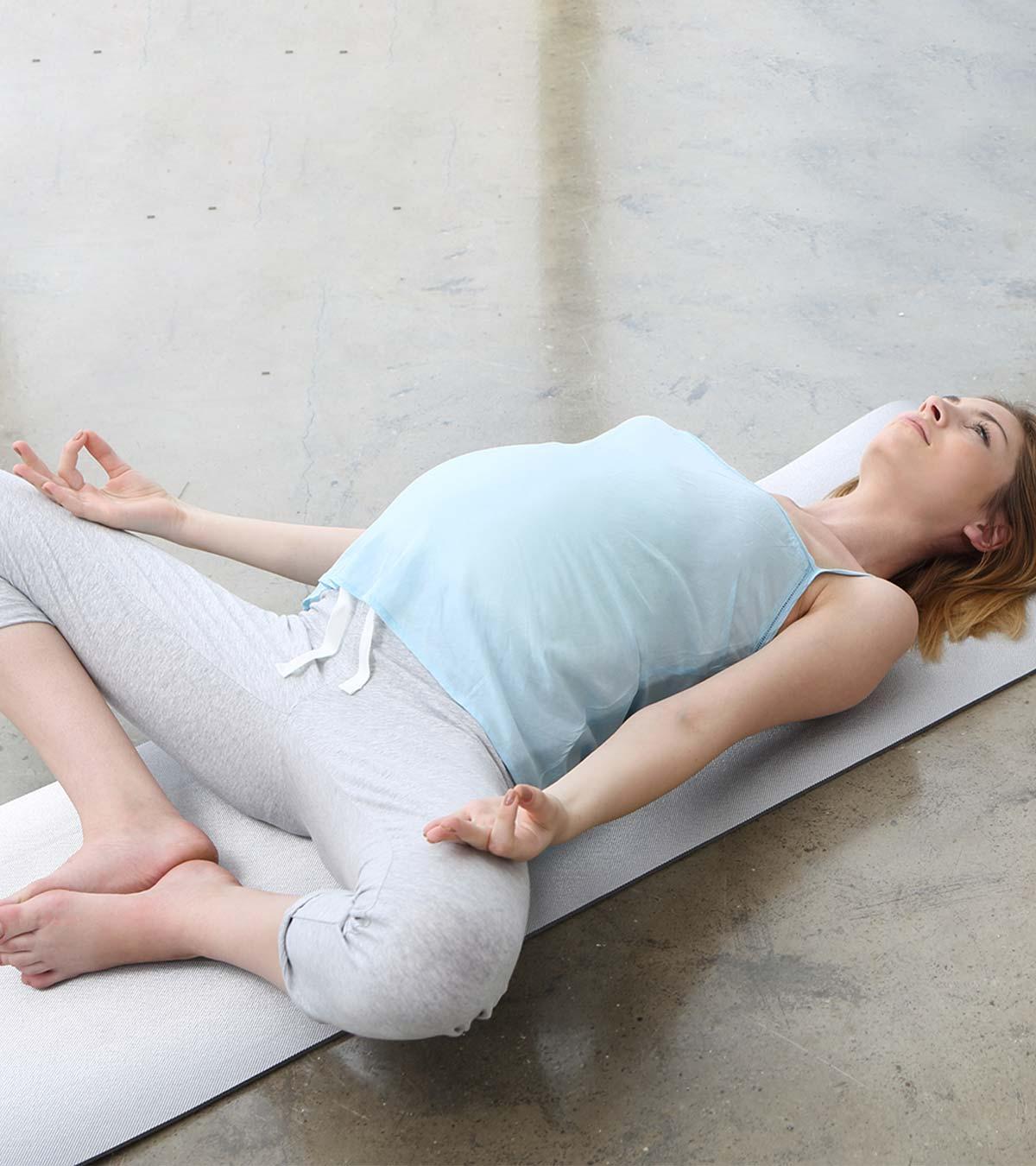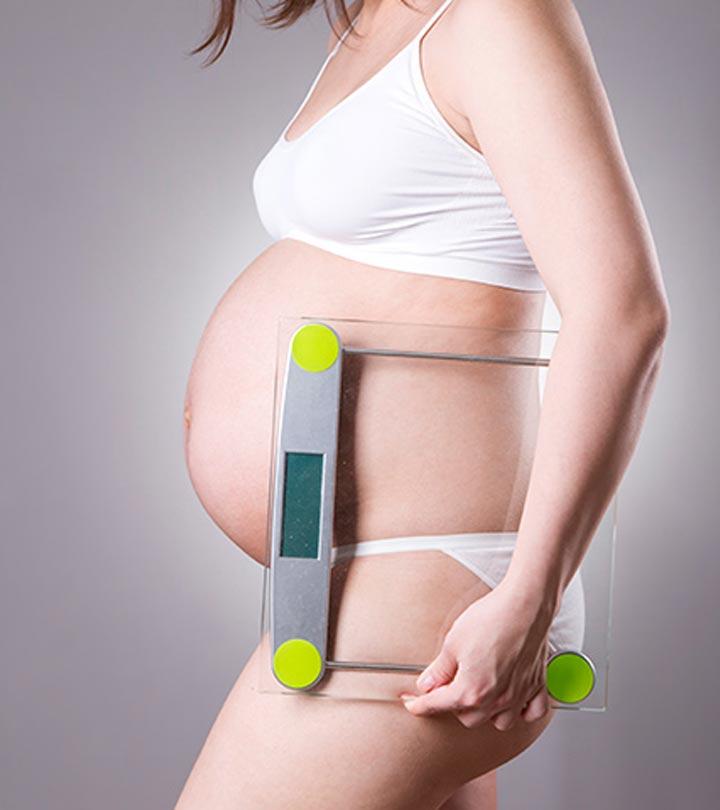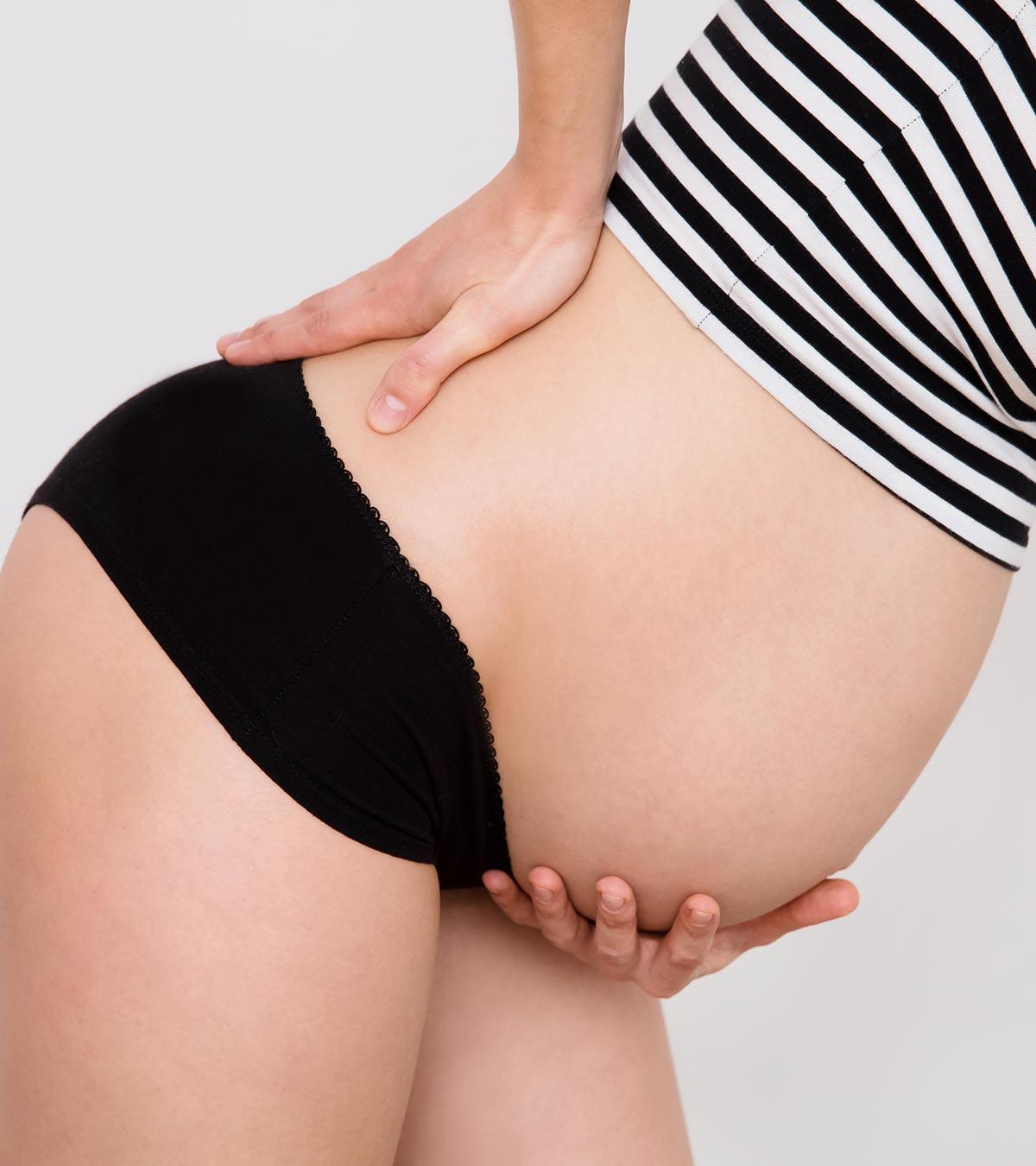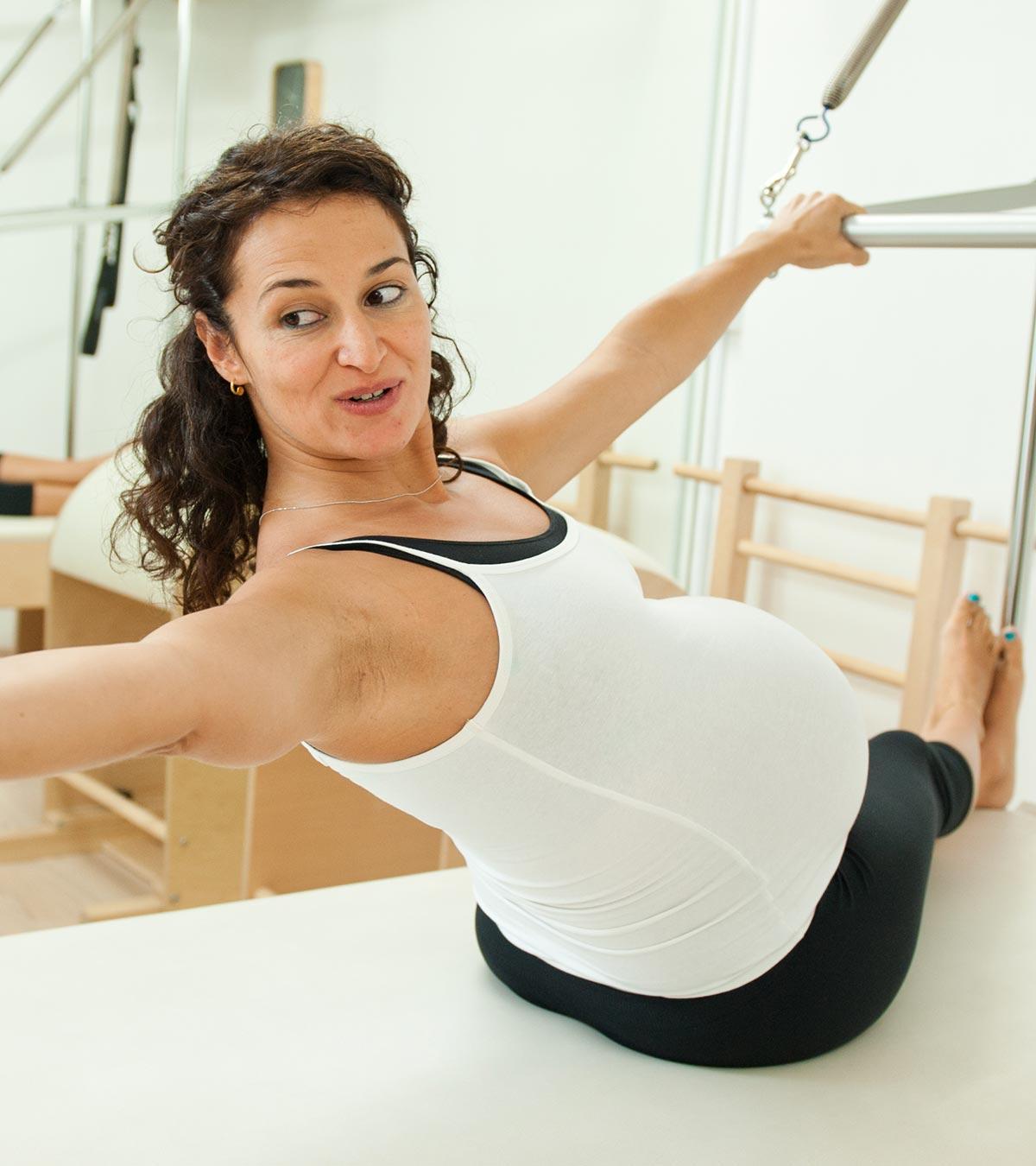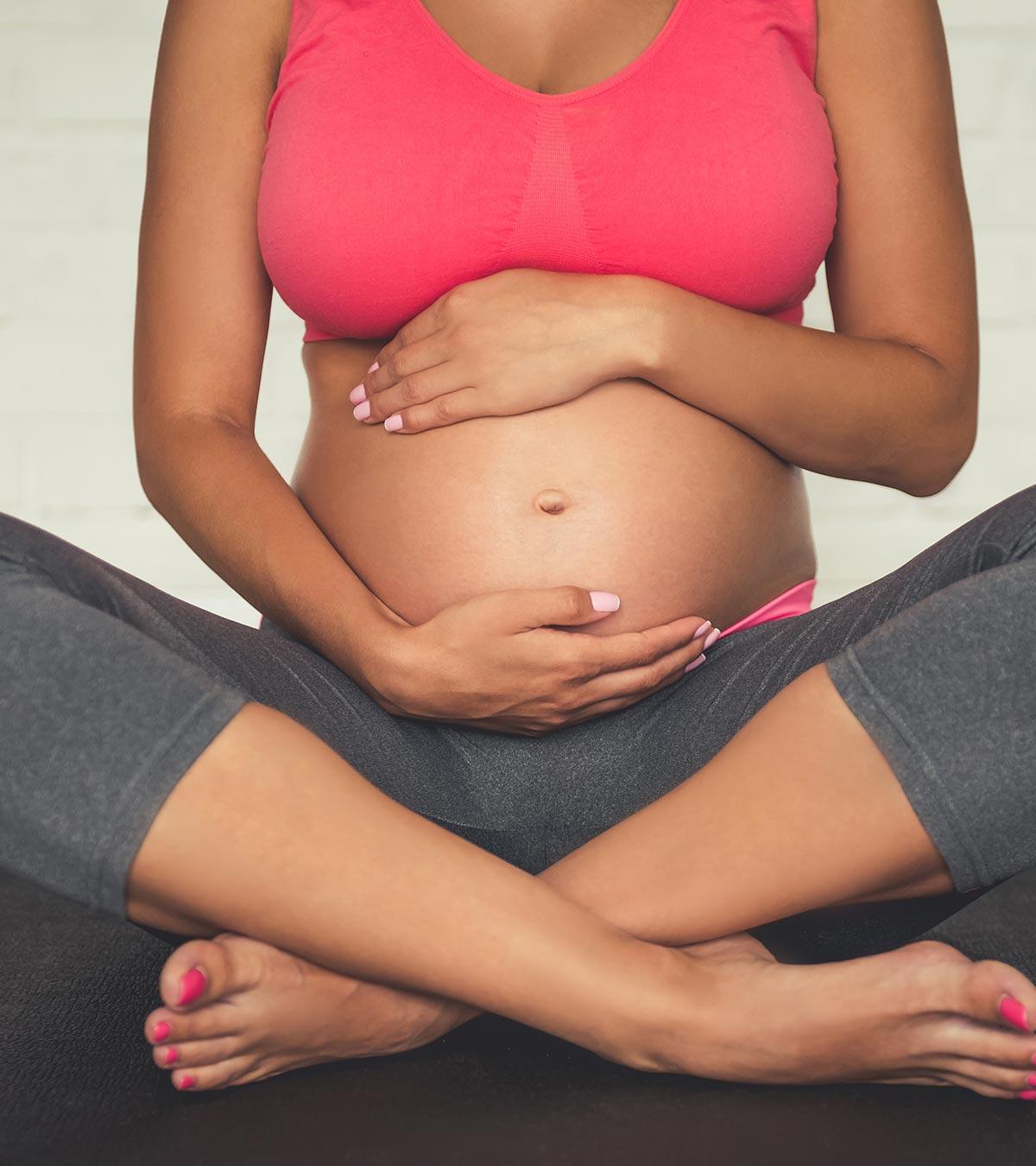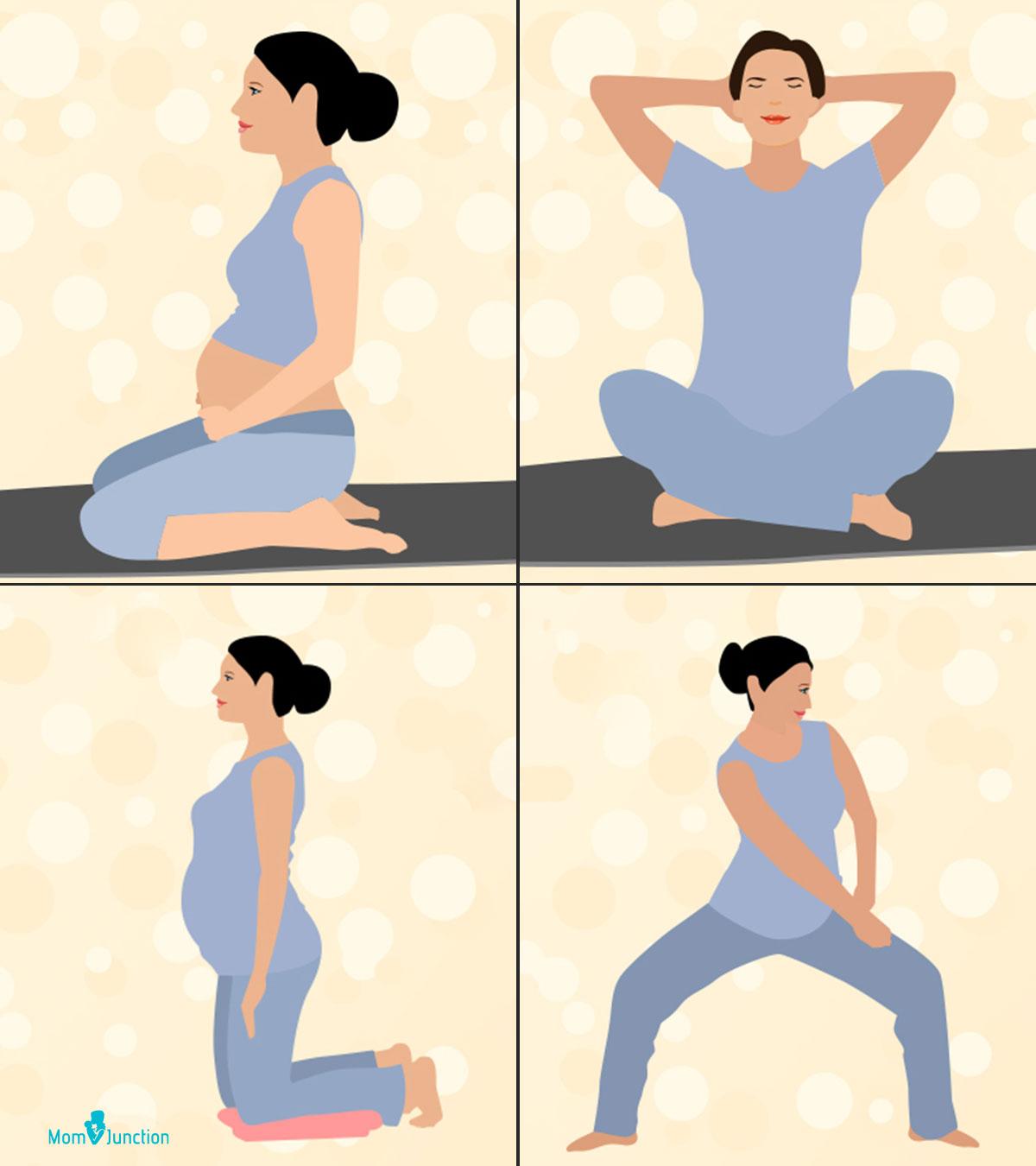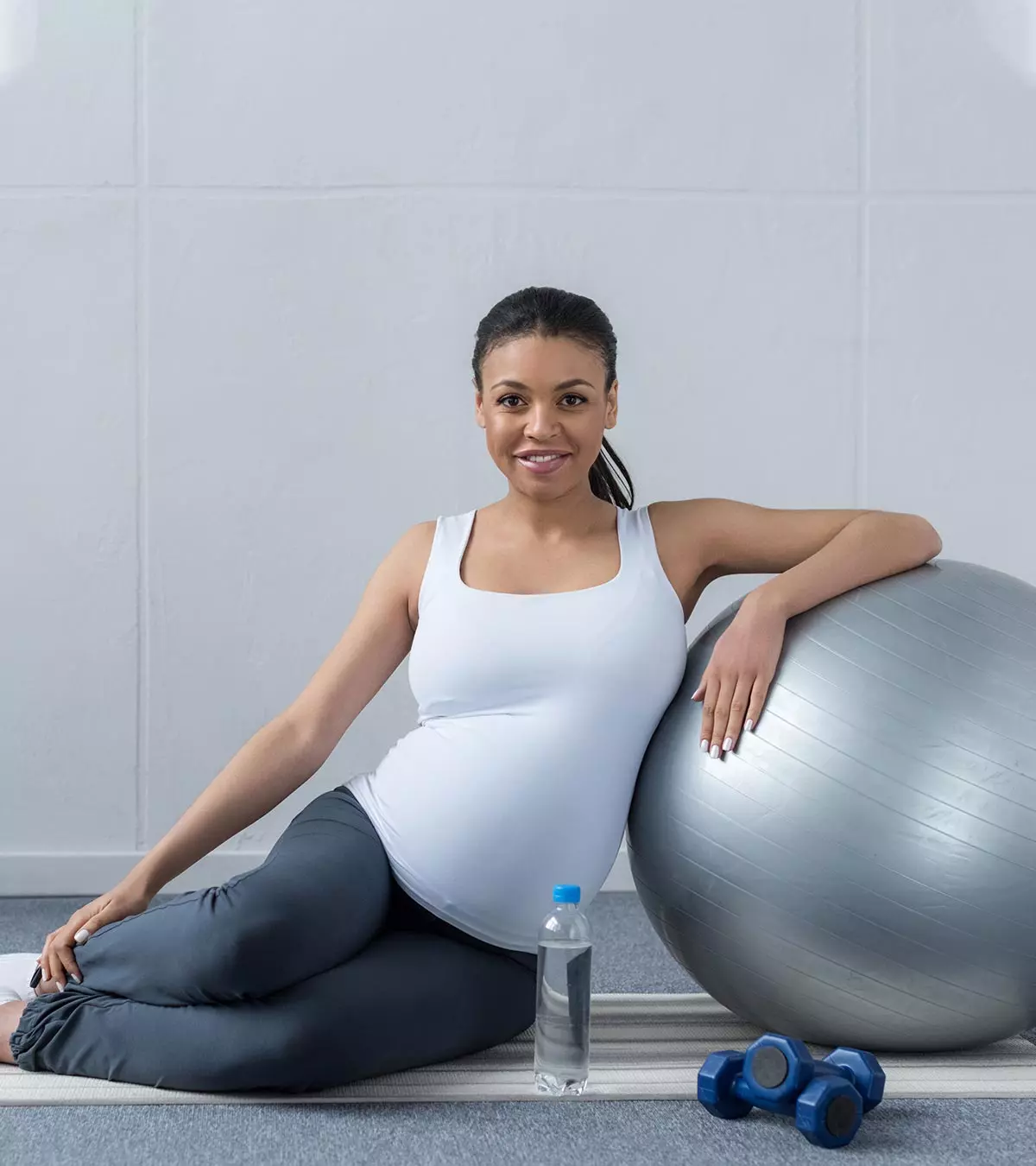
A birthing ball is a fitness ball that women can use for performing prenatal exercises. Regular use of a birthing ball is also considered a labor prep exercise that can smoothen the birthing process and improve the chances of vaginal delivery. In this post, we tell you the benefits of doing birthing ball exercises during pregnancy.
You should use a birthing ball under expert guidance. Read on as we tell you about the birthing ball you should buy, the ideal size you should use, the right time to start using a birthing ball during pregnancy, and tips on using a birthing ball safely during pregnancy.
What Is A Birthing Ball?
A birthing ball, also known as a labor ball, is a big inflatable exercise ball made of rubber. It is a standard fitness ball that can be used by pregnant women for fitness during pregnancy and post pregnancy (1). Following a birthing ball routine is a safe and beneficial non-pharmacological technique to increase your chances of having a vaginal delivery.
What Are The Benefits Of Using A Birthing Ball?
Here are a few potential benefits of using a birthing ball (2).
- Provides back pain relief and improves mobility.
- Stimulates blood flow to the pelvic area, where the placenta and uterus lie
- Offers counter-pressure to your perineum and thighs
- Gives excellent support to your knees and ankles
- Helps reduce spinal pressure
- Can eases labor pain and reduce the duration of labor (3)
- Can reduce the anxiety and pain from contractions
- Helps open up the pelvic floor muscles
- Helps you remain in an upright position, which works with gravity for efficient baby decent
- Corrects the baby position before the birth
Note that some people may feel dizzy or ill while using the ball. If you do, refrain from using it.
What Is The Difference Between A Birthing Ball And A Gym Ball?
Birthing balls and gym balls are almost similar and made of anti-burst materials, which means they only deflate slowly and not get punctured. However, there are a couple of differences between the two: birthing balls are bigger than gym balls, and they come with an anti-slip finish.
What Type Of Birth Ball Should You Buy?
Buy a birthing ball which meets the following criteria:
- The size of the ball depends on your height (see the table below). When you sit on it, your feet should touch the floor properly
- Take the one with anti-burst feature and an anti-slip finish; In any case, do not keep these exercise balls near sharp objects, rough surfaces, direct heat generators such as heaters, radiators, blowers, open fires and stoves.
- Should be able to bear your weight
- Choose from a reputed brand so that you can be sure of its quality
- It should be pressure-tested and take up to 300kg weight
What Is The Ideal Size Of A Birthing Ball?
The ideal size depends on your height, as mentioned in the table below.
| Your height | Ball size (centimeters) |
|---|---|
| Less than 5’2” | 45cm |
| 5’2” – 5’8” | 55cm |
| 5’9” – 6’3” | 65cm |
| Above 6’3” | 75cm |
Note: When you sit on the ball, the hips need to be higher than the knees. Otherwise, it is an indication that the ball is small for your height or it needs to be filled with more air. The birth ball usually deflates with time and can be inflated using an air pump (4).
Sitting with your knees higher than the hips can disturb the fetal position and lead to prolonged and painful labor.
Tips For Using A Birthing Ball For The First Time
Here are a few tips for first-time users of a birthing ball.
- Place the ball on a carpet or a rug and not on the floor. Go barefoot, or wear anti-skid shoes. Have someone hold your hand and support you from the back when sitting on the ball for the first time.
- Place your feet firmly on the floor to gain your balance. Place one hand on the ball and slowly lower yourself to sit on the ball.
- Now, place your hands on the knees and try rocking the pelvis sideways, and back and forth. Once you feel you are comfortable with it, bounce on it a little.
- If you are not comfortable with the rocking or bouncing movements, place a chair near you for support.
- Make sure that there is enough space around you when you exercise on the ball.
- Breathe normally, control your exercise movements, and stop the activity if you experience any pain.
Knowing when to use the birth ball during pregnancy is essential to stay safe and make the most of it.
 Quick tip
Quick tipWhen Can You Start Using A Birthing Ball?
The first trimester is the best time to start using the birthing ball. You can also start exercising on it later during the pregnancy, although you may have difficulty getting used to it, considering how much your body would’ve changed with the growing baby.
Next, we tell you about how the birthing ball can be used during pregnancy, labor and after birth.
How To Use A Birthing Ball During Pregnancy?
During pregnancy, you can use the birthing ball:
For sitting comfortably when working or resting:
- It is much easier to get on and off on the ball than it is to sit on a soft sofa or a hard chair.
- Sitting on the ball is also a mini workout. Rocking and bouncing on it gently can keep your tummy and back muscles upright.
For some mild exercise:
- Birth ball offers the necessary balance, aids in posture improvement, and exercises your abdominal muscles. It gives the required support to bear the pregnancy weight.
- Rock your pelvis sideways and back and forth while sitting on the ball (pelvic tilts). Hold your core tight, tilt your pelvis back slightly and try curving your lower back gently at the same time. Repeat to strengthen your uterus and lower back. You should not involve your shoulders when doing a lower back stretch, and movement should start from the waist and below.
- Rotate your hips clockwise and anti-clockwise while sitting on the ball.
- Remain in a kneeling position, and then lean over the ball (resting child’s pose). Now rock your hips front to back. It helps you relax.
You can also try pelvic floor exercises while using the birthing ball. You may find it much easier, and you will be working on the lower tummy muscles.
For changing the baby’s position in late pregnancy:
- Lean forward on the ball and try to get on your knees. Forward-leaning positions while on the ball will help the baby adopt the upright birthing position.
- This will make the baby move into the anterior position, with their back towards your tummy.
Though the baby is not going to remain in the same position until labor, exercising on the ball can at least offer you some relief from back pain.
How To Use A Birthing Ball During Labor?
Working out on the ball can help with childbirth preparation, aid in core strengthening, and make you feel comfortable before labor. Some healthcare providers also recommend using TENS (transcutaneous electrical nerve stimulation, drug-free option for pain relief) along with the birthing ball to cope up with early labor.
Here is how you can use the birthing ball during labor:
1. Sit on the birthing ball with your feet shoulder-width apart. Now rock your pelvis side to side and from front to back (like using hula hoops). This helps to stretch out your body so that the baby can move into the right birthing position.
2. Get onto all your fours by hugging the ball, and gently lift your bottom from a kneeling position called the resting frog squat. Rock your pelvis sideways.
4. Lean forward over the ball while standing, with the ball placed on the bed or an elevated platform. This labor ball position gives gravity needed for the baby’s descent.
5. Bouncing gently on the ball strengthens your legs and improves your ability to balance. It is also helpful in giving counter pressure you require during labor.
6. If you are worried about falling off the birthing ball, consider seeking balance training, or try sitting upright on the peanut ball, an alternative to the rounded birth ball. (5).
7. Lie on your side using a peanut ball. It helps you rest and sleep well. It also keeps your pelvic region open when resting.
Besides making normal delivery easy, the birthing ball can also help you stay fit and recover faster after childbirth. Check with your doctor before planning to use a birthing ball. You can get a personal trainer or a specialist dealing with women fitness, if necessary.
An anonymous author and a mother of two shares her experience using a birthing ball during pregnancy to alleviate painful contractions. She says, “Once the pain had passed, I got up and grabbed my birthing ball, which again has always been very effective at getting rid of the aches and pains of pregnancy. I bounced around on the birthing ball for the next few pains, but it didn’t make the pain go away like it usually does (i).”
 Quick fact
Quick factHow To Use A Birthing Ball After The Baby’s Birth?
You can use birthing ball after the birth of the baby in the following ways:
- You will feel sore for some days after the delivery. Sitting on the ball is more comfortable than sitting on a hard surface.
- Once you get the baby to latch conveniently, you can sit on the ball when breastfeeding. It can be better than slumping on the bed.
- You can also cuddle and soothe your crying baby while sitting on the ball.
- Exercising with the ball helps tone up your post-pregnancy body.
- When the baby is ready, they may also like to stand, walk and scoot on the ball.
 Quick tip
Quick tipFrequently Asked Questions
1. Can bouncing on a birthing ball hurt the baby?
No scientific studies have proven that bouncing on a birthing ball while pregnant might harm the baby. However, be mindful of rocking or moving gently on the ball with support nearby.
2. Does using a birthing ball help soften the cervix?
Yes. Studies have shown that using a birthing ball can significantly aid the process of cervical ripening (6).
3. How long should I bounce on a birthing ball?
There is no set time limit for bouncing on a birthing ball. Women may receive instructions on how to use the ball and other pain relief techniques based on their condition. The birthing ball exercise may start for 15 minutes and continue as long as they feel comfortable and according to their preference (8).
4. Is it better to bounce or rotate on a birthing ball?
Both bouncing and rotating on a birthing ball have their benefits. Bouncing on the ball can improve posture, exercise muscles, and relieve back pain, while rotating or rocking may help open the pelvis and support swaying movements during labor (7). Using the birthing ball is recommended based on personal comfort and after consultation with your doctor.
5. How often should I use a birthing ball during pregnancy?
The regularity of using a birthing ball during pregnancy varies. A pregnant woman may use it frequently until labor (9). However, it is advisable to consult your healthcare provider for personalized guidance, considering your individual needs and circumstances.
6. Are there any birthing ball exercises that can help with pelvic pain?
Yes, birthing ball exercises such as pelvic tilting, pelvic circles, and the child’s pose can help alleviate pain in the pelvic region (10).
You may try birthing ball exercises during pregnancy to reduce pain and discomfort. The ball can be used any time during pregnancy and even during the final weeks of pregnancy. These exercises may also improve the body postures and strengthen the pelvic muscles. They are also recommended to increase the chance of natural childbirth and to ease labor woes. However, do not forget to seek your obstetrician’s opinion before beginning exercises with a birthing ball in pregnancy.
Personal Experience: Source
MomJunction articles include first-hand experiences to provide you with better insights through real-life narratives. Here are the sources of personal accounts referenced in this article.
i. Birth story;https://uc-help.livejournal.com/5332.html
Infographic: What Are The Benefits Of Using A Birthing Ball?
Birthing balls have the potential to offer several benefits during pregnancy, including increasing your chances of a vaginal delivery. The infographic below outlines some of these benefits for you to explore. Save and share the infographic with other expectant mothers too! Illustration: Momjunction Design Team
Key Pointers
- Pregnant women can exercise throughout and after their pregnancies using birthing balls.
- A birthing ball has been demonstrated to speed up labor, ease back pain, improve blood flow to the pelvis, improve posture, help expand the pelvic muscles, correct the baby’s position before birth, apply counter-pressure to the thighs and perineum, and lessen spinal pressure.
- The ball should be the appropriate size for the user’s height and include features such as an anti-burst function and an anti-slip coating.
- Although it can be used later in the pregnancy, the birthing ball is most useful in the first trimester.
Image: Stable Diffusion/MomJunction Design Team
References
1. K Mirzakhani et al.; The Effect of Birth Ball Exercises during Pregnancy on Mode of Delivery in Primiparous Women; JMRH (2014)
2. L Lago AM, M Pan L, T Bouza E; The birthing ball: rediscovering a non pharmacological resource of great importance in the birth process; Rev Enferm. (2014)
3. Leung RW et al.; Efficacy of birth ball exercises on labour pain management; Hong Kong Med J (2013)
4. Roger Brignell, The Pilates Handbook, p.161
5. C M Tussey; Reducing Length of Labor and Cesarean Surgery Rate Using a Peanut Ball for Women Laboring With an Epidural; J Perinat Educ. (2015)
6. Hai-Chuan Shen et al.; Birthing ball on promoting cervical ripening and its influence on the labor process and the neonatal blood gas index; PubMed Central (2021)
7. Using a birth ball Tommy’s
8. May Pui Shan Yeung et al.; Birth ball for pregnant women in labour research protocol: a multi-centre randomised controlled trial; BMC Pregnancy and Childbirth (2019)
9. Sitting on the Birth Ball Exercises and Massage; Madriella Network
10. Exercises to help pelvic girdle pain; HSE.ie







